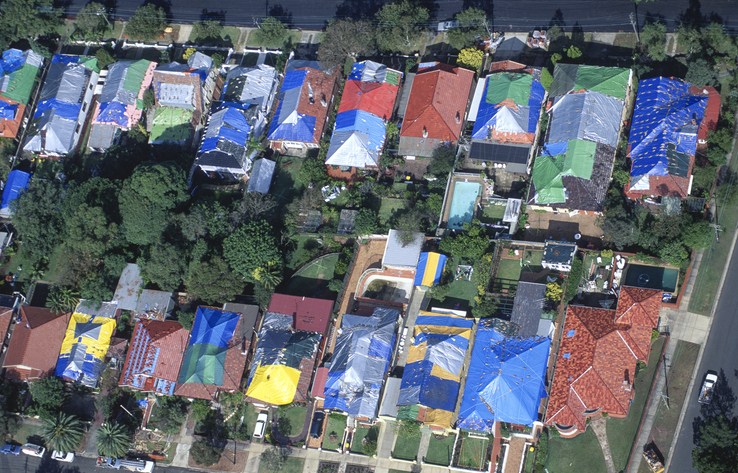‘Disaster season’: What is that?
October 9, 2025
Anika Wells, in announcing a meeting with three telco giants to discuss Optus’s Triple Zero emergency call system catastrophe in September, referred to the need for Australians to have confidence in the system before the coming “disaster season”. By that she meant summer. Is there really such a season?
Yes, there is. But we shouldn’t over-state its existence, and we must recognise that weather-related agents of disaster, including bushfires and floods, are not limited to short periods. Tropical cyclones, too, can strike well after the end of summer, and severe thunderstorms bringing large hail and damaging winds likewise can occur at any time. We are talking here about frequency of occurrence at different times of year, not weather-related disasters being possible only in a particular few months.
Take bushfires. They begin in the far north of Australia, mainly in June and July. Their season of principal occurrence gets later the further south you go, with March and April being months of strong risk in Tasmania.
But lately things have blurred: our worst-ever bushfires during “Black Summer” (2019-20) started near Port Macquarie in July and homes were being lost in numbers by early September, well before the official start of the New South Wales Bushfire Danger Period on 1 October. So Black Summer was actually black Winter, Spring and Summer, and major fires burned simultaneously in every state and territory for the first time.
And take floods. In the far north of New South Wales, using the Moree area on the Gwydir River as an illustration, the principal season is summer while the Murray River’s is in late winter and spring. But the Gwydir sometimes experiences flooding in winter and the Murray in summer. Again, it’s a matter of variable frequency at different times of year, not of the flood risk being confined to short (and different) periods in each case.
The impact of climate change on floods is less studied and less obvious than for fires, but there are clear trends of increasing amounts of rain over short periods. Thus flash flooding (flooding very soon after rain) is becoming more common worldwide.
Thunderstorms, too, have periods of high and low frequency, but again they can occur, and severely, outside the seasons in which they are most likely. The famous Sydney thunderstorm of 14 April, 1999, large hail from which damaged tens of thousands of houses in the southern and eastern suburbs and the inner city, was one such case: the Bureau of Meteorology was in the act of closing its severe weather warning desk at the end of the usual season when hailstones up to grapefruit size struck many suburbs. Severe thunderstorms in NSW are most common up to the end of February, but they are not non-existent substantially later.
Things are changing as climate change evolves. Bushfire seasons are gradually but inexorably getting longer, and there is more overlap between seasons in different parts of the country than once was the case. Likewise, hemispheric fire risk seasons increasingly overlap, with problematic consequences for the sharing of resources (like large fire-fighting aircraft) between countries like Canada and Australia.
It gets more complicated yet. Clear evidence exists that the tropics are “expanding” in climatic terms. This does not relate to changes in sunrise and sunset at different times of year or to seasonal differences in average temperature regimes — the lines marking the tropics at 23.3 degrees north and south are not shifting — but areas outside the lines are receiving less rain as the years go by. This has ramifications for bushfires. Cyclones might also reach higher latitudes and with more severity of impact there.
So the natures of bushfire and cyclone occurrence are changing. It is likely we will eventually see evidence of something similar in terms of floods and perhaps also in relation to hail- and windstorms. The trend of “tropic expansion” appears to have persistence: there is nothing to suggest it will not continue.
The term “disaster season” is a shorthand. There’s nothing wrong with that, but it would be unfortunate if shorthand led people to think that weather-related disasters can occur only in a brief period in a location. Weather-related disaster events can occur at many times, even though generally they are most frequent in much of Australia in the warmer months.
One worry in all this is the speed of the change. Sea-level rise, for example, is very slow in the context of human life-spans – but it is also inexorable. On average around the globe, sea level has risen more than 20cm since about 1880, which is roughly two lifespans as traditionally reckoned. But the rate of rise has been increasing, nearly half of the change since 1880 having occurred in the last 30 years. Moreover the increase appears to have momentum: nothing indicates that it has yet peaked.
The future for the atoll nations of the Pacific and coastal cities around the world may be even more problematic than we have so far realised. The same might be said for coastal erosion.
Those who deny climate change need to demonstrate why sea-level rise is occurring if it is not because of increased temperatures associated with climate change. They must also explain why bushfire severity is increasing and fire seasons are becoming longer.
Perhaps the deniers are prisoners of the view afforded by the human lifespan. Tony Abbott, who is highly dismissive of climate change, once observed that a century of photography on Manly Beach showed no evidence of sea-level rise. But cogent comment requires one to consider real evidence and to think in terms of geological rather than human time. Abbott does neither.
The views expressed in this article may or may not reflect those of Pearls and Irritations.

